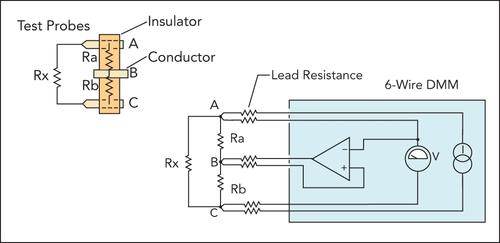Six-Wire Technique Nulls Stray Resistance
November 15, 2011

The boss picked you to design equipment to measure in-circuit resistances on circuit boards as they reach the end of a production line, and a colleague suggested you investigate six-wire measurements. But why would you need six wires to measure an in-circuit resistance?

A four-wire ohmmeter, usually part of a digital multimeter (DMM), connects the DMM's current source to a resistor via a pair of leads. A second set of leads connects the DMM's voltmeter to the resistor. Resistances in the current leads do not matter, because the DMM measures the voltage at the resistance. And the resistances in the voltmeter leads have little effect, because the DMM draws a very small current. That technique works for a standalone resistor, but when you have a network of resistors and must measure the resistance of only one, things get complicated.
The figure shows a typical circuit in which you must measure resistance Rx in the presence of two other resistances. In this case, resistances Ra and Rb will affect a two- or four-wire measurement, because current from the DMM source will flow through them, as well as through resistor Rx. By using an operational amplifier -- essentially a buffer amplifier -- you drive point B in the circuit to the same potential as that found at point A. Thus, no current flows through Ra. This technique goes by the name "guarding." However, when the op amp drives point B to the same potential as point A, current will flow through resistor Rb. That current can reach tens of milliamps, but it will not affect the voltage measured across the unknown resistance. You can buy six-wire measurement equipment.
Even if you won't measure resistance in a network, this type of guarding comes in handy in other accurate resistance measurements, such as those on a test fixture. Unseen dirt, absorbed moisture, and thin oil films on the insulating portion of a fixture will provide a high-resistance path in parallel with a resistance you must measure. But if you split the fixture and insert a conductor between the two contacts, you have the equivalent of the resistances Rx, Ra, and Rb described earlier. A six-wire DMM can drive the conductor and prevent current flow through or on the insulator, as shown in the figure. Nylon, for example, will absorb moisture in a humid atmosphere, and thus its insulating properties will change.
You might hear of other six-wire measurement techniques, but they involve shielding or separate wires to drive a device, correct the drive signal, and measure a sensor output. They do not use guarding to null unwanted resistance.
For further reading:
Can You Test & Measure With an MCU?
Pickering Electronics offers a 32-page reference, "Reed RelayMate," here.
About the Author(s)
You May Also Like



